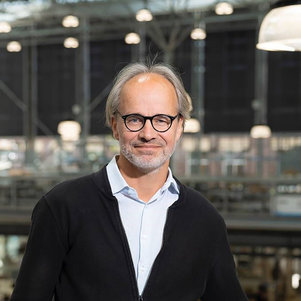Prof.dr.ir. A. van Timmeren
Professor of Environmental Technology & Design - Department of Urbanism
‘The chair in Environmental Technology & Design covers three important fields: the environment (humans and the living environment), technology, and design & integration. At different scales, however starting mainly from the perspective of the urban dynamics and of emerging theories of complexity related to this. Within this context, we search for the proper way to apply technology and its integration in order to achieve significant environmental and liveability improvements, both now and in the future.
Our most important current research areas include ‘intelligent cities’ and systems, in which intelligent energy storage and exchange play a pivotal role, as well as research in the area of green-blue cities, supported by data and GIS. We are also conducting many studies on circularity and new innovative techniques (decentralised systems, additive manufacturing, smart waste management), as well as the relationship between cities and hinterlands (peri-urban areas) within the programme on ‘Urban Metabolism’, urban environments and infrastructure.
Major challenges: Great potential
Urban development offers us many challenges. One of the greatest challenges concerns urbanisation, particularly with regard to rapid change, with greater densities and complexity and within a context of increasing urgency in the area of sustainability and liveability. Such challenges are readily solved in outlying areas and new cities, as they facilitate the integration of sustainable systems, which often require space. Under conditions of less space and more streams (energy, water, food), the challenges are many times greater, often involving ‘double-complex’ systems from the perspective of technology and users.
‘Resilience’ is another major challenge. Major changes are needed in the area of climate adaptation. Intelligent systems and the use of ‘real-time’ data are playing an increasingly important role in this regard. They offer the possibility of developing dynamic systems that are capable of reacting to and anticipating changes in real time. I see great potential in all of the challenges that we are facing. For us, “Every problem is a potential opportunity”.
Perspective
In my chair, I regard the balance between design (and integration), technology and humans as extremely important. The focus of research in other areas is too often one-sided. I try to retain this integrated view, approaching research from all three of the aforementioned perspectives. Only in this way can we arrive at a true paradigm shift.
When I see the manner in which we are accomplishing this and how much we are achieving, I am very proud of my excellent, young team, which has recently experienced enormous growth – we are constantly adding more people who can further strengthen our knowledge and expertise. Besides, the team is becoming more international every day.
I am proud of the impact that our studies are having. They are ground-breaking and integrating. I consider the interaction between knowledge development and application-oriented research important. It accelerates the route between fundamental research and the proposition of solutions for society.
Significant contributions
The chair has made many successful contributions.
For example, I am proud that we were at the foundation of the Amsterdam Institute for Advanced Metropolitan Solutions (AMS) and that we are continuing to play an important role within it. The Institute is a wonderful initiative, which brings together many aspects of the city, environment, living quality and data. We are also achieving considerable success in the area of green-blue infrastructures and cities. Examples include the project involving the relocation of the Swedish city Kiruna, as well as initiatives in São Paulo (HidroAnel) and, closer to home, Rotterdam, Nijmegen and Zwolle. Ordinary cities are based on grey systems. We have found a way to use these green-blue systems to make them more resilient – not only in theory, but in projects that are actually being realised. It is fantastic when innovative research and the solutions that emerge from it are applied in practice. When this happens, we are making a significant contribution to the solution of common and emerging problems in society.
Taking nothing for granted
I feel committed to a better world, and I am idealistic by nature, but I am also pragmatic and creative. Together with the excellent team of researchers and teachers, this ensures that the chair can arrive at many innovations and solutions (obviously through trial and error). Questioning everything and taking nothing for granted is the guideline for this process: “Are we on the right track? Are we asking the right questions? Is this the best we can do from the human perspective?” Et cetera. I am always reflective in the interest of continual improvement and innovation.’
Arjan van Timmeren (1969) is Professor of Environmental Technology & Design. Since 1997, he has been working as a specialist in sustainable technology for buildings and area development within the Department of Urban Planning in the TU Delft Faculty of Architecture and the Built Environment. He completed both his undergraduate and graduate degrees cum laude, in addition to working as a consultant to various architects and engineering firms in the Netherlands, Italy and Spain.
More information
Education, publications and secondary employment
Chair of Environmental Technology & Design
